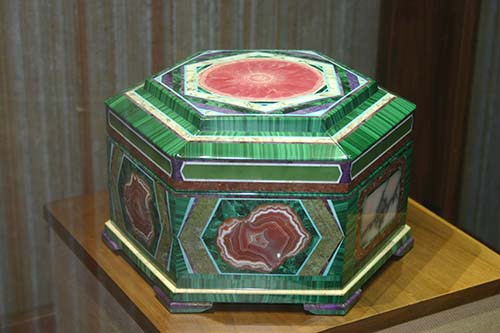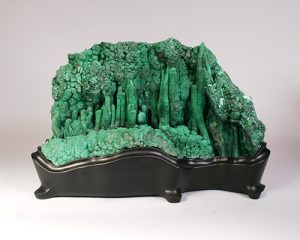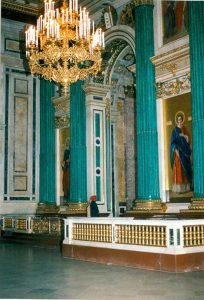
Editor’s Note: This is the second in a two-part series about Malachite. Enjoy Part I>>>
Story by Bob Jones
One of the earliest-known sources of malachite was mined by the Egyptians in the Sinai Desert thousands of years ago. Since that time, this lovely, green hydrous copper carbonate has been mined in quantity all over the world. To describe more than a fraction of all the sources of this mineral would be impossible in a magazine article, but a handful of sources are astounding, due to the sheer quantity or unusual types of malachite they produced.
Russia’s Ural Mountains was once the source of tons of the world’s most beautiful banded malachite, and the copper mines of the Katanga (Shaba) Copperbelt of Central Africa are currently yielding huge masses of green copper carbonate. Russia is unquestionably famous for its amazing banded malachite gem material. Artisans, decorators, and museum experts agree that Russian malachite is the most beautiful in the world. It was mined in such quantities that artisans were able to produce breathtaking malachite objects that are now found worldwide. Visit stately palaces in Mexico, England and Europe, and many state buildings and countless museums throughout the world, and you can view wonderful creations made of Russia’s malachite. These objects are highly prized and eagerly displayed, and their value borders on priceless.
Legacy of Marvelous Malachite
Russian malachite exhibits light- to dark-green bands, some so dark as to be almost black. The bands can be any width, from under an inch to several inches wide. The curving, undulating bands are spectacular, taking many forms, from bull’s-eyes to graceful, sweeping curves.

Two Russian copper mines, the Mednorodyskoye and Gumshevskit, established in the Middle Ural Mountains in the 1800s, were particularly productive of large pieces of malachite. Among the multiton masses of malachite recovered was one chunk that weighed around 250 tons, with many others in the 50-ton range! These large masses were not completely solid, but were shot through with vugs and cavities. This made obtaining large slabs impossible, but explains why the Russians developed the technique called “Russian malachite mosaic”.
The czars recognized the value of this material immediately, and had huge quantities shipped to the royal lapidary works in Ekaterinburg. Established in 1723 by Peter the Great, it is named for his wife, Yekaterina, who became Catherine the Great. In them, the malachite masses were turned into objects of art in an orgy of creation: breathtaking vases, fireplace mantles and frames, clock bodies, candelabra, table and desktops, and many other items. The Russians even used malachite to decorate an entire room.
What most of us do not realize is that the huge malachite objects of art are not solid—they are veneered! The veneering technique was developed by Russian artisans because the malachite was too vuggy to be cut into large, solid slices. The technique known as Russian mosaic involves making an object out of metal, such as copper, or stone, like basalt or marble, then veneering it with thin slices of malachite. The patterns of these slices had to be carefully matched—band to band, natural design to natural design—so that the finished work looked like solid malachite.
Malachite in Many Forms
How large are some of these Russian malachite mosaics? The malachite-veneered doors leading into the heart of Chapultepec Palace, in Mexico City, are about 10 feet high. Even more amazing are the malachite columns in Saint Isaac’s Cathedral, in Saint Petersburg. There are five columns on either side of the entrance to the altar—10 columns in all. Each measures 40 feet high and 2 feet across. The core of each fluted column is a copper cylinder, and the cylinders have been veneered with malachite.
If you have ever done much lapidary work, you know how difficult it is to cut thin slices of malachite, which is a relatively soft mineral (Mohs 4). The Russian lapidary artists had to cut the Uralian malachite into thin sheets that measured only 1 mm thick! Cutting thin slabs is difficult enough; try matching them to each other so that the finished object looks as if it is a solid malachite piece. Each and every color, each and every band and swirl, had to match up! Today, the old glue is drying out, and repairs have to be made on these malachite mosaic objects. Still, you can’t see the joints where these pieces of malachite have been matched.
I was fortunate to visit Saint Isaac’s Cathedral while shooting the video “Russian Gem Treasures”. I wanted to photograph those 10 malachite columns, but ran into a problem: Photographs were not allowed unless you paid for the privilege. Officials told my producer, Michael Leybov, that it would cost me $100; however, if Michael, a Russian, took the photos, the fee was only $10! So I set up my tripod and camera and got everything framed properly, and then Michael pushed the camera plunger again and again.
As impressive as the Saint Isaac’s columns are, I found the Malachite Room, in the Winter Palace—now the State Hermitage Museum—to be the most remarkable. The room is larger than a basketball court. At one end is a malachite fireplace with gold trim. There are columns, tables, and a huge assortment of objects done in malachite and gold. Even the chandeliers were made of malachite. It was really a green sight to behold!
Evolution of Malachite Sources
I doubt there is an official count of the number of objects that were made from Russian

malachite. Czars used them as important and very showy gifts when they traveled to visit dignitaries and royals in other countries, so they are all around the world.
Unfortunately, the supply of malachite from Russia’s mines dried up long ago. The lapidary orgy ended relatively quickly in the years following the discoveries, and Russian malachite is no longer seen on the mineral market.
Fortunately, another malachite source, this one in Central Africa, came to light in the early years of the 20th century. The copper deposits, however, were well known to natives hundreds of years before the Europeans invaded. Known early on as the Roan-Antelope Belt, this vast copper-bearing region is now called the Katanga (or Shaba) Copperbelt. It extends over a vast part of the southern Katanga Province in the Democratic Republic of the Congo (Zaire).
The area trends northwest to southeast and covers an area of over 150 miles by over 40 miles. It holds at least six operating open-pit mines, which produce tons of malachite and other copper minerals, along with cobalt minerals.
Velvet Malachite
Some “primary” malachite has been found in the Katanga Copperbelt, but far more important are the vast tonnages of malachite that have been mined. The bulk of the malachite is solid, velvet malachite, but there are also huge quantities of superb malachite stalactites and stalagmites. These long, tapering, green structures can reach well over a foot in length and are found in multiple units of subparallel growths in all sizes. When cut across the vertical, the stalactites reveal a beautiful interior with circular bands. Many of these formations take a wonderful polish.
The velvet malachite pieces from the Katanga source can be huge. Some pieces I’ve seen exceed 3 feet in length, and I suspect their size is governed only by the miner’s ability to extract them from the deposit.
As for cutting-grade malachite, very large quantities have been mined in this African country and used in many ways. It is not unusual to see a malachite dealer at a show offering large quantities of carved and polished malachite objects like animals, ashtrays, eggs, candleholders, and just about anything else imaginable. Larger polished pieces are used for decorative displays, and lapidary artists love to work with good, solid Zaire malachite. They keep in mind that inhaling the dust of any copper species is apt to cause breathing problems over time.
Superb examples of the use of cutting-grade malachite include slices cut from stalactites, with their bull’s-eye patterns. Zaire malachite is seen in the magnificent work of Jim Kaufman and Nicolai Medvedev, intarsia artists whom we featured in the article “Russian Renaissance”, in the November 1984 issue of Rock & Gem. It seems most appropriate to me that Medvedev, a very talented Russian lapidary, has applied his talents to malachite from Zaire. His work is now seen at major gem shows and displayed in museums like the noted Lizzadro Museum of Lapidary Arts, in Elmhurst, Illinois, and the National Museum of Natural History (Smithsonian).
Assorted Malachite

The supply of African malachite seems endless, but it should be noted that most mineral collectors are far more excited about the wonderful assortment of minerals, including rose-colored cobaltian calcite and superb, lustrous, octahedral crystals of carrollite, that come from these mines. In fact, dozens of fine mineral species have been found in the copper deposits of the Katanga Copperbelt, ensuring a good supply of minerals for the future.
While malachite is a common secondary mineral in countless copper deposits, one form of this green mineral that is particularly appealing to collectors is malachite pseudomorphs after a mineral, most often azurite. Bisbee, Arizona, was noted for its specimens, and the Russian mines certainly yielded fine ones in its day. The recent malachite pseudomorphs from the Milpillas mine, in Sonora, Mexico are considered world-class.
Two sources of unusual malachite specimens should be mentioned: the historically important copper mine at Chessy-les-Mines, France, and the more recently worked Emke mine, in Namibia. Both deposits produced fine, malachite-coated cuprite crystals. The Chessy crystals are almost always simple octahedrons, under an inch long, though some crystals do exceed that. Small clusters of two or three octahedrons were also found. This mine was worked in the 1700s and 1800s, and any specimens seen today are from old collections.
Cuprites Specimens
The malachite-coated cuprite specimens from the Emke mine came out in the latter part of the 1900s. One report I received while there was that, upon entering the mine after a blast, the miners saw an exposed wall of calcite on which were many large malachite-coated cuprite crystals on calcite. The cuprite crystals were all dodecahedrons, some of them elongate.
The cuprites, when the malachite was removed, proved to be gemmy red and could be faceted into large gems—300 carats or more. When I visited the site in the 1990s, the mine was closed and nothing was available. The internet and mineral shows are the only sources for these important malachite-coated cuprites now.
These two articles have only touched on malachite, the copper carbonate that is a wonderful display mineral and a superb and most colorful lapidary material.


















